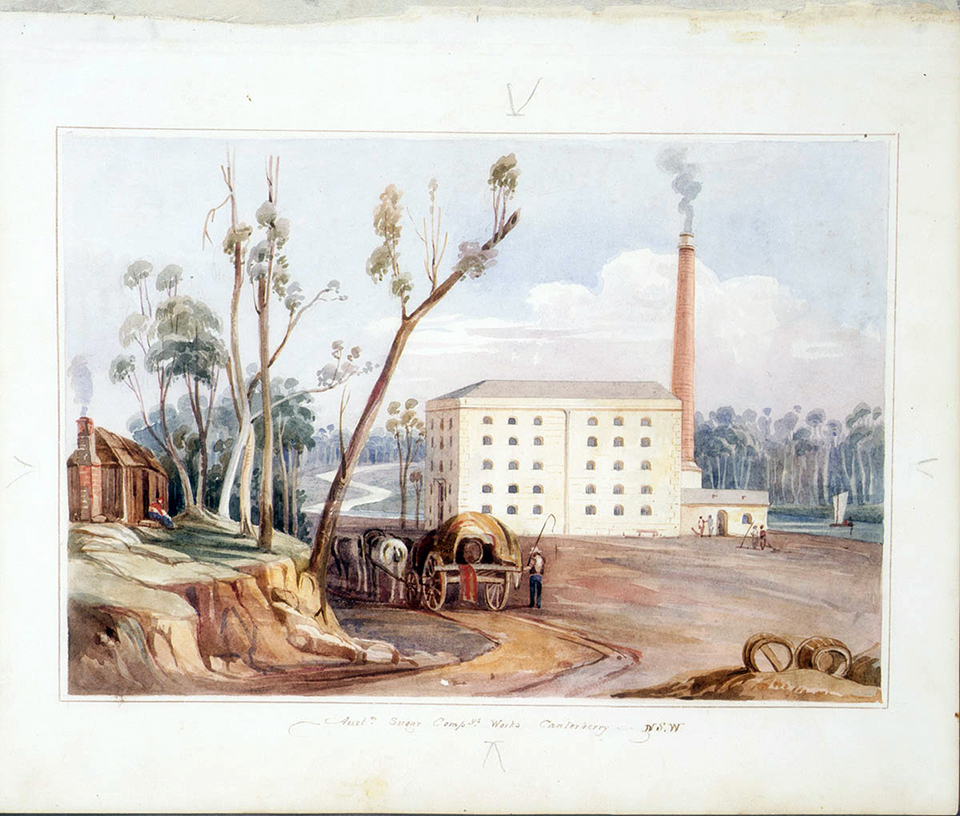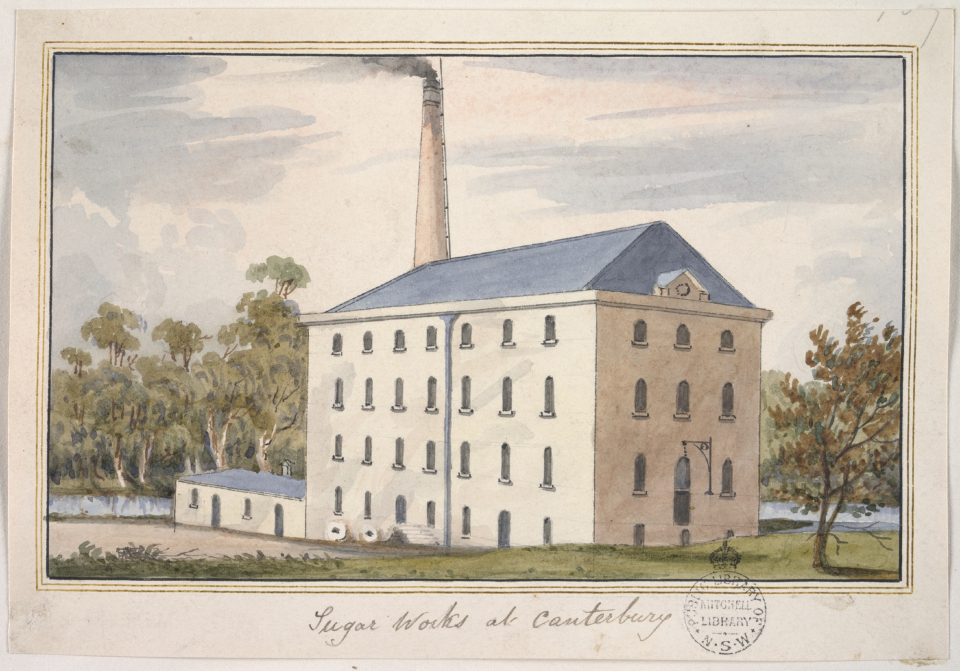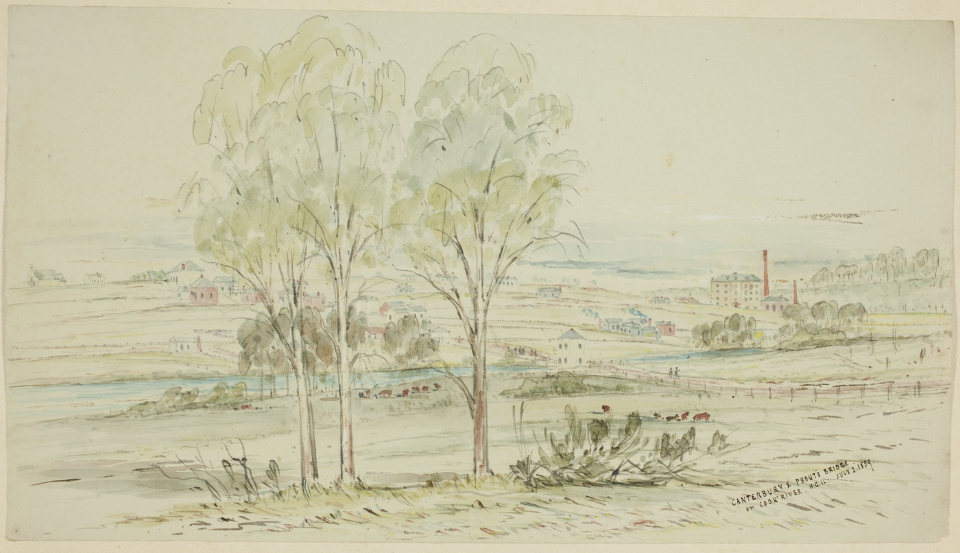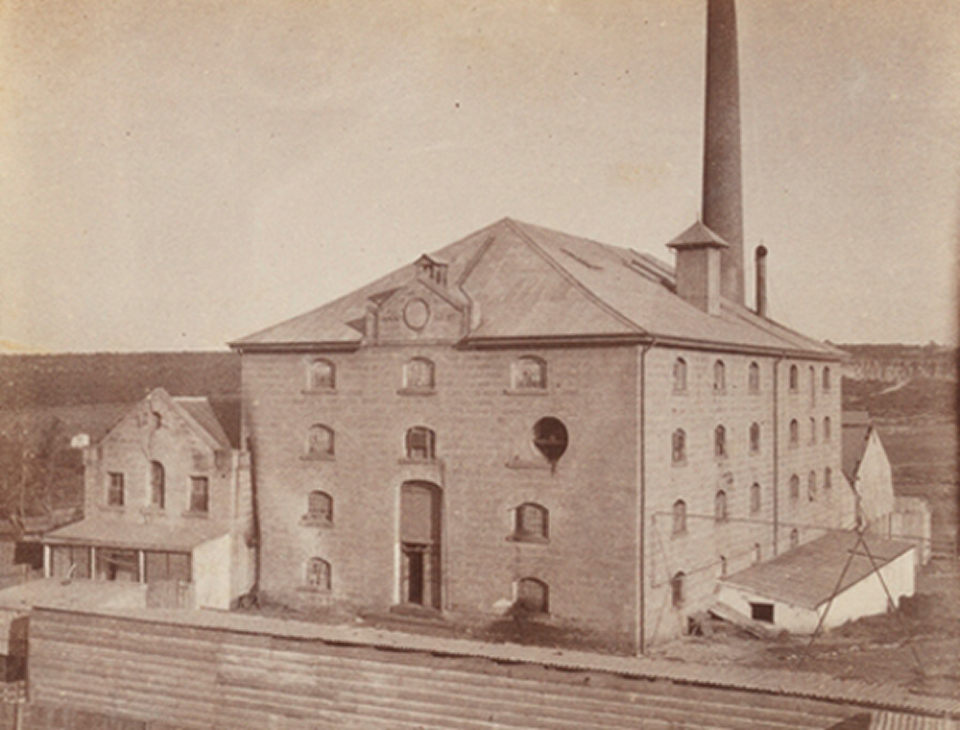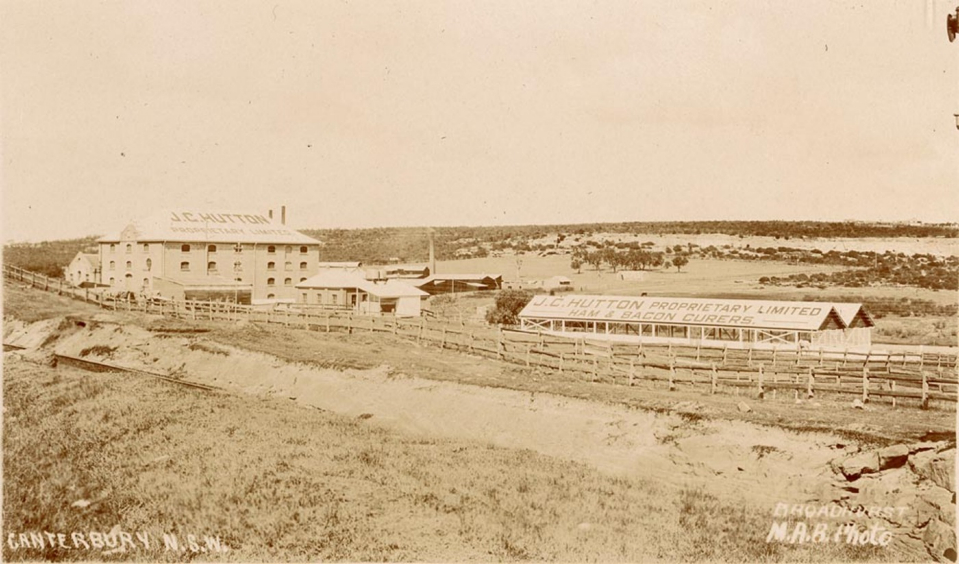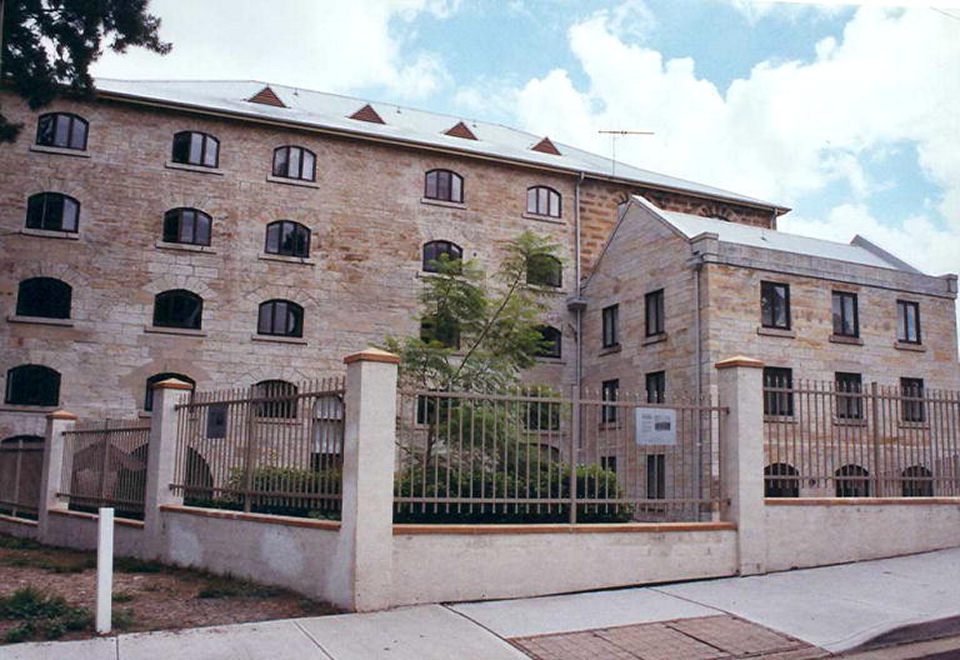The Dictionary of Sydney was archived in 2021.
Canterbury Sugarworks
Citation
Persistent URL for this entry
To cite this entry in text
To cite this entry in a Wikipedia footnote citation
To cite this entry as a Wikipedia External link
Canterbury Sugarworks
Refining sugar
[media]On the northern bank of the Cooks River, downstream from the Canterbury Road Bridge at Canterbury, is a Georgian stone building with 'ASC 1841' on the pediment. Sometimes wrongly called the Canterbury Sugar Mill, the historic Canterbury Sugarworks was in fact a sugar refinery. In a sugar refinery, raw sugar from elsewhere is used to produce refined sugar, whereas a sugar mill is located close to where sugar cane is grown – the cane is crushed and pressed in rollers to extract the juice, which is filtered and boiled to remove the water, producing raw sugar.
In the past, raw sugar was sent to refineries that were usually close to the markets for the refined sugar. This is what happened at the Canterbury Sugarworks in the 1840s and early 1850s, where the raw sugar was imported from the Philippines and processed into refined sugar. These days, there are substantial financial and environmental benefits associated with annexing a refinery to a sugar mill located in a cane-growing area, including large savings in energy costs, considerably lower capital costs and reduced labour costs [1].
Australian Sugar Company
[media]The history of the Canterbury Sugarworks began in England in 1839 when Francis Kemble, a London company promoter, convinced William Knox Child, a banker and Deputy Lieutenant of the County of Kent, to invest in his scheme to set up a sugar refinery in Sydney. Lured by Kemble’s grandiose predictions of profits to be made, Child sold his estate and put his capital into the venture, and the Australian Sugar Company was formed [2]. Before 1840, all sugar for the Australian colonies was imported [3].
The partners arrived in Sydney in June 1840 on the Ann Gales, bringing with them the nucleus of a workforce and some obsolete equipment that had belonged to Kemble. Construction of the Sugarworks, built by David MacBeath and his team of Scottish stonemasons on the banks of the Cooks River, began late in 1840. The wages of many of the labourers were paid in allotments of land in the new village of Canterbury. Sandstone was quarried on the site, just north of the building, and the ironbark timber was cut from the forests of today’s Earlwood, across the Cooks River. The river was dammed to provide fresh water for the boilers and, largely through Child’s managerial skill, all was in readiness for processing to begin in September 1842.
Australasian Sugar Company
Before the refinery commenced production, arguments between Kemble and Child led to Kemble replacing Child as manager. The difficult establishment work having been done by Child, Kemble took over at the ideal time with processing about to begin. Child was later to win a libel verdict and a small damages award against Kemble. The disagreements, and the effect of the 1840s depression, led to the dissolution of the original company and the formation of a new company, the Australasian Sugar Company, to take over the assets of the Australian Sugar Company [4].
Raw sugar was imported from Manila and was brought by cart from Sydney to Canterbury for refining. It is sometimes said that the raw sugar was brought up the Cooks River by boat, but this was impossible because of the dam at Tempe.
Colonial Sugar Refining Company
[media]The Australasian Sugar Company’s factory was extremely efficient – only the distance of haulage stood against it. Throughout the 1840s, the Sugarworks manufactured loaf sugar and molasses, and a flourishing village of slab huts grew up around it. The manager of the Sugar Company expanded the business, eventually taking over Bowden’s rival establishment in Liverpool Street. In the early 1850s, Ralph Mayer Robey, Clark Irving and Edward Knox, three of the directors, purchased the Brisbane Distillery on Blackwattle Creek, and it was their decision that the Canterbury factory be closed down in August 1854. The Australasian Sugar Company was re-formed as the Colonial Sugar Refining Company in 1855, and the refinery moved to the Chippendale building, leased from the directors.
Industrial use
[media]The Canterbury Sugarworks building remained vacant until 1884, when it was converted by Arthur Blacket into a heavy engineering factory for his brother, Owen, a director of Blacket and Co. The government planned to build a new railway line from St Peters to Liverpool, and the factory building was very close to the route. When the decision on the railway took longer than anticipated, the company went bankrupt, and the building was vacant once more.
In 1900, the Sugarworks building was sold to Edward Denham for a refrigeration works. It was renamed the Canterbury Bacon Factory, and the interior was redesigned as a meat processing works. [media]The site was used by J C Hutton Pty Ltd from 1908 to 1982, first as a bacon factory and later for smallgoods manufacture. In the late 1970s, the building was refurbished as a staff amenities centre.
J C Hutton Pty Ltd relocated their factory complex in 1982, and the site was purchased by Nick Scali Furniture Ltd, in 1983. An interim order under the Heritage Act was placed on the Sugarworks in August 1982, replaced by a Permanent Conservation Order in 1985.
Fire
The Sugarworks building was vacant from 1983 until it was gutted by fire early on the morning of Tuesday 13 February 1996. It was believed the fire was deliberately lit. Graphic pictures of the flames rising high above the building were shown on television, and Sydney newspapers carried the story. Local newspapers featured the fire on the front page with colour photographs. The roof of the Sugarworks was destroyed and much of the interior was damaged. Although the interior had been altered over the years, the original hardwood posts and beams and other internal timber work were still in place, and so the damage to the fabric of heritage value was considerable.
Residential conversion
A development application for the conversion of the Sugarworks building into apartments, and the construction of further units elsewhere on the site, was lodged with Canterbury City Council in 1995. An appeal by the owner, Nick Scali Furniture Ltd, against the deemed refusal of the development application was heard by a Commission of Inquiry on 20 and 21 January 1997.
Subsequently, in line with the recommendations of the Commission of Inquiry report, the Minister for Urban Affairs and Planning, Mr Craig Knowles, refused the application. Mr Knowles said that the heritage significance of the Sugarworks building was of immense value and deserved to be protected. The development would dominate and obscure views of the northern aspects of the building, and it would be negligent to allow such development to proceed, he said. He asked Canterbury City Council and the developer to consider alternatives.
In 1997, the Heritage Office agreed to the developer creating additional window and door openings in the sandstone walls of the Sugarworks building. An amended development application was submitted in 1997 and various modifications followed in subsequent years. The final result was that the Sugarworks building was converted to provide 20 residential units, with flats and townhouses constructed on the surrounding land. These were occupied in 2004.
National significance
[media]For a number of reasons, the Sugarworks building is of national significance. It is one of only two privately built pre-gold rush industrial buildings left in Sydney, it is the earliest surviving element of the Australian sugar industry, and it is the foundation of one of Australia’s major companies, CSR (Colonial Sugar Refining) Co Ltd.
The building is also important to the history and heritage of Canterbury city. It was the impetus for the establishment of the village of Canterbury, and it has dominated the Cooks River landscape since it was constructed. It has been a landmark loved by generations of residents.
References
Lesley Muir, 'The Story of Canterbury’s Sugar House', National Trust Magazine, June, 1981
Lesley Muir, 'A Wild and Godless Place: Canterbury, 1788–1895', Master of Arts Thesis, University of Sydney, 1984
AG Lowndes (ed), South Pacific Enterprise: The Colonial Sugar Refining Company Limited, Angus and Robertson, Sydney, 1956
Notes
[1] 'Cane Sugar Mill', Wikipedia, http://en.wikipedia.org/wiki/Cane_sugar_mill, viewed 21 November 2012; 'Sugar Refinery', Wikipedia, http://en.wikipedia.org/wiki/Cane_sugar_mill, viewed 21 November 2012
[2] AG Lowndes (ed), South Pacific Enterprise: The Colonial Sugar Refining Company Limited, Angus and Robertson, Sydney, 1956, p 12
[3] AG Lowndes (ed), South Pacific Enterprise: The Colonial Sugar Refining Company Limited, Angus and Robertson, Sydney, 1956, p 402
[4] AG Lowndes (ed), South Pacific Enterprise: The Colonial Sugar Refining Company Limited, Angus and Robertson, Sydney, 1956, p 12, 402



